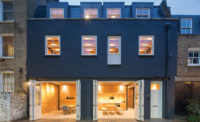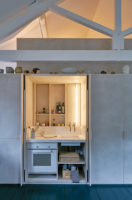Kitchens need an efficient configuration and durable surfaces. But a teaching kitchen completed a year ago for cooks ages 8 to 11, at Brunswick Park Primary School in London, also needed to display the cooking process, encourage students to participate, and ensure safe, hands-on involvement for up to eight little chefs simultaneously.
Additional Content:
Jump to credits & specifications
“There’s a bit of a movement here to get kids to cook and eat healthily to fight obesity. Because of that, there’s a new opportunity to build these specialty classrooms,” says Tom Surman, a principal at the architecture firm Surman Weston, which designed the new kitchen.
In fact, the UK’s Department for Education has made cooking lessons a compulsory part of the national curriculum and recently instituted a requirement for dedicated teaching kitchens. Brunswick Park had been holding its cooking classes in a staff room, but, rather than renovate this space, Surman suggested revamping a century-old two-story caretaker’s cottage that had been sitting unused in a corner of the school-yard for five years. “It’s common here for a lot of old brick buildings to dot school grounds. Many of these are crumbling but are quite nice, and have a certain charm,” Surman says.
To salvage that charm, his team first had to rip out interior partitions, an existing kitchen, and part of a chimney hearth; relocate the stairs; and demolish some load-bearing walls while supporting the second floor on steel beams. Once the ground level was opened up, an east-facing wall in space previously occupied by the stairs became an ideal location for the new 330-square-foot kitchen—full of daylight from windows on either side.
Removing a drywall ceiling, added over the years, revealed pine joists with diagonal bracing that support the floor above. Keen to preserve the details and add height and interest to the space, Surman left them exposed, installed identical new bracing where it was needed, then painted the adjacent new steel structure pink for a fun contrast. New pine stairs, located along the north wall, were also stained pink to emphasize their treads and risers. The playful hue is echoed in the kitchen’s simple shelf brackets and complemented by the custom kid-friendly cabinet doors, fabricated from recycled yogurt containers.
The motivation for this approach was pedagogical. “We deliberately exposed the profile of the stairs and other elements, so the kids would understand the building has components, the way a recipe has ingredients,” the architect says. But showcasing the ceiling structure meant rerouting lines for gas, electricity, and plumbing. Because areas on the second level were designated as therapy rooms, which required soundproof construction, the architects built up the floor by nearly 3½ inches with layers of plywood, rubber, and rock wool insulation, then snaked service lines underneath.
Revealing the building’s bones provided a tactile and engaging learning environment, and the central island serves as a stage for displaying cooking techniques and inviting students to join in. It is visible from every seat at the custom U-shaped work surface, topped in the same recycled plastic as the cabinet doors. Next up for the firm is a similar but more ambitious facility in the London neighborhood of Hackney, to serve an entire borough and accommodate classes of 30 students. Says Surman, “We hope that will have an even bigger impact.”
CreditsArchitect: Surman Weston
Lead architect: Tom Surman
Engineering: Scanding Workshop
General contractor: D.F. Keane |
SpecificationsFlooring Nora Systems
Tabletop and cabinets Smile Plastics
Paint Thermoguard, Dulux
Lighting Eglo
Doors and windows Touchwood Joinery |












Post a comment to this article
Report Abusive Comment